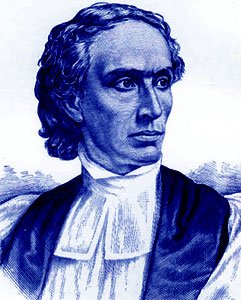Eighteen years after the impressive folio Great Bible was published, a small octavo Bible was published in Geneva. This 1557 New Testament marked the beginning of a Bible that, according to Cleland Boyd McAfee, “drove the Great Bible off the field by sheer power and excellence.”

The work of preparation of this New Testament was anonymous. So was the Preface, which was less customary: evidence points to it being the singlehanded work of William Whittingham, an English gentleman and Oxford scholar. A manuscript Life of Whittingham in the Bodleian Library in Oxford tells of a group of ‘learned men’ in Geneva meeting to ‘peruse’ the existing English versions of the New Testament (thus making the first such revising committee in English Bible history.) The ‘learned men’ mentioned were indeed learned: Miles Coverdale; Christopher Goodman, another Oxford man from Brasenose and then Christ Church, who had become Lady Margaret Professor of Divinity; Anthony Gilbey; Thomas Sampson, from Oxford and Cambridge, who went on to be Dean of Christ Church, Oxford — he had most recently been close to the Hebrew scholar Immanuel Tremellius at Cambridge and Strasbourg; Dr William Cole; and William Whittingham himself. They were possibly joined in committee by John Knox, and certainly later for the whole Bible by William Kette (or Kethe), John Baron, John Pullain, John Bodley and W. Williams.[4] Knox had been chosen as minister from its first day by the English-speaking congregation at Geneva, but did not arrive there until September 1556. He left for Scotland in 1557, but returned early in 1558, finally departing in January 1559, having received the freedom of the city of Geneva.

The Geneva Bible was a huge contrast to Henry VIII’s large folio Great Bible, or Matthew’s before that: but the contrast was not only in the pleasing small size. It is also handsome. For the first time, an English bible text was printed not in heavy ‘Gothic’ Black Letter in northern Europe by printers in Antwerp or London, but in Switzerland, by Conrad Badius, the son of the master-printer of Paris, in a clean, clear Roman, a French style also influenced by Italian printers trained in the more refined humanist manner. Its pages are uncluttered, the text ruled, with wide margins at the sides, top and bottom, giving an attractive sense of space. The paper shows signs of having been carefully selected: some surviving copies remain unusually fresh; one of the two copies in the Bodleian Library, Oxford, and the copy in Lambeth Palace Library, have paper of still remarkable whiteness, as no doubt do others. The neat notes, an average of two per page, are in the outer margins in roman, with occasional references in italic on inside margins. The thickest cluster of marginal notes accompanies the opening chapters of Matthew’s Gospel. Some pages, even of the Epistle to the Romans, have no notes at all. Also for the first time in an English Bible, while the traditional markers A,B,C, and so on are retained in the margins, the text is divided into numbered verses, following the Greek New Testament by Stephanus made in Geneva in 1551, ultimately from Pagninus’s edition of the Vulgate made at Lyon in 1527, though — also for the first time in this 1557 New Testament — each verse starts a fresh line with its number, whether it is the beginning a new sentence or not. This again was new, for the first time outside Latin or Greek. Again for the first time in an English Bible, words not in the Greek, thought to be necessary additions for English clarity, are in italic.
The Geneva Bible was the “Bible of the Protestant Reformation”, and the Bible of the Puritans and Pilgrims. It was the first Bible taken to America, brought over on the Mayflower. The Geneva Bible is the Bible upon which America was founded. You can imagine, most early American colonists, who were fleeing the religious oppression of the Anglican Church (Church of England), wanted nothing to do with the King James Bible of the Anglican Church

The 1560 Geneva Bible, also known as the Breeches Bible (due to a reference in Gen 3 where Adam and Eve are given ‘Breeches’), became a fast favorite shortly after publication. Shakespeare quoted it and the Puritans carried it across the Atlantic to America. This is the Bible by the people, for the people. This Bible did not remain upon the lectern but was brought into the home for daily Bible study. The Geneva notes that filled the margins were added to help the reader understand and interpret the Scriptures. The notes were so popular that they were included in several King James Bibles as late as 1715.
